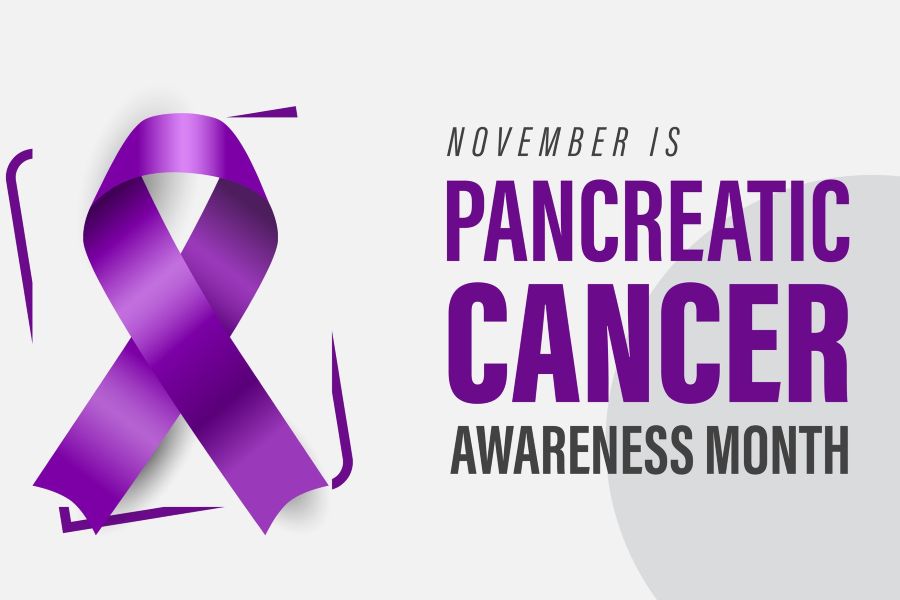
In medical school, young doctors are taught, “When you hear hoofbeats, think horses, not zebras.” Attributed to University of Maryland infectious disease specialist Dr. Theodore Woodward, this old saying reminds physicians to think about common diseases before considering rare ones.
But at high-volume cancer centers, seeing and treating unusual conditions is part of everyday care. Pancreatic neuroendocrine tumors (PNETs), often associated with the zebra symbol as a rare disease, are sometimes overlooked since they make up only about 3% of pancreatic malignancies. This is an important cancer to recognize during Pancreatic Cancer Awareness Month in November.
Unlike standard pancreatic cancer, or pancreatic adenocarcinoma, which refers to cancers that arise from the cells lining the pancreatic duct, PNETs arise from the neuroendocrine cells of the pancreas known as the islets of Langerhans. These cells can produce hormones such as insulin, glucagon or somatostatin.
The vast majority of PNETs are “nonfunctional,” meaning they do not produce hormones at a level that causes symptoms. Many patients have no symptoms and are diagnosed incidentally when undergoing abdominal scans for other reasons. Others develop symptoms from the tumor pressing on nearby structures, causing abdominal or back pain, unexplained weight loss or jaundice due to blockage of the bile ducts.
Patients with “functional” PNETs have unique symptoms related to overproduction of specific hormones, usually assessed by an endocrinologist. Rarely, PNETs are linked to an underlying genetic syndrome that requires further testing to rule out other types of tumors.
When a PNET is suspected, patients are referred to an advanced gastroenterologist for an endoscopic ultrasound with needle biopsy to confirm the diagnosis. PNETs are sometimes incorrectly dismissed as “benign” tumors. It is true that most PNETs grow more slowly than pancreatic adenocarcinoma, and very small PNETs may have little impact on a patient’s quality of life or lifespan. However, PNETs are technically a form of cancer because they can spread over time to lymph nodes or through the bloodstream, sometimes reaching the liver, abdominal lining, lungs or bones.
The treatment of PNETs is complex and requires an expert multidisciplinary team made up of medical oncologists, surgical oncologists, pathologists, interventional radiologists and nuclear medicine specialists. Pathologists evaluate PNETs and categorize them into three grades to reflect how aggressively the cells divide under the microscope.
Low-grade, nonfunctional PNETs smaller than 1 centimeter do not require treatment and can be safely monitored with intermittent scans. Tumors between 1 and 2 centimeters are usually observed initially, and the decision to pursue surgical resection depends on the tumor’s size and growth over time, the patient’s fitness for surgery and individual preferences to balance surgical risks with a generally low-risk disease.
For PNETs larger than 2 centimeters or those that produce hormones, surgical resection is the mainstay of treatment if there is no spread beyond the pancreas. For tumors in the head of the pancreas, a Whipple procedure is typically performed to remove the head, nearby duodenum, end of the bile duct and lymph nodes. Tumors in the body or tail of the pancreas are usually treated by removing the distal pancreas and spleen.
Less extensive surgery, such as enucleation — where only the tumor and minimal nearby tissue are removed — or spleen-preserving surgery, may sometimes be offered but may not adequately achieve negative margins or lymph node harvest. A robotic approach is used whenever appropriate to allow a minimally invasive surgery that can reduce postoperative pain and hospital stay.
Patients whose PNETs have spread to the liver may be candidates for additional operations to remove or ablate the liver tumors while also addressing the primary pancreatic tumor.
Some tumors cannot be removed because of involvement of major blood vessels or extensive disease in or outside the liver. These patients may be observed for a short period to monitor tumor growth. If the disease progresses, a synthetic version of the natural hormone somatostatin may be given to help slow growth.
Patients with disease concentrated in the liver may be evaluated for liver-directed therapy, in which targeted treatments are delivered directly into the tumor, sometimes with low-dose radiation. Another option is peptide receptor radionuclide therapy (PRRT), which uses targeted low-dose radiation administered over several months to treat tumors throughout the body. Finally, chemotherapy and targeted therapy may be administered by a medical oncologist to help slow progression in patients with active tumor burden.
Patients with PNETs should know that even though they have a rare tumor, they are not alone. At Northside Hospital Cancer Institute, we treat a high number of patients with PNETs and are recognized by the National Pancreas Foundation as a Center of Excellence for Pancreas Cancer.
Our patients are cared for by a comprehensive team of physicians and surgeons, along with experienced allied health professionals, including oncology dietitians, nurses, physician assistants, therapists and genetic counselors — all working together to help patients have the best chance of beating their disease.
Learn more about the Liver & Pancreas Program at Northside Hospital Cancer Institute.

